创建项目
先创建一个spring项目。
然后编写pom文件如下,引入spring-boot-starter-security,我这里使用的spring boot是2.4.2,这里使用使用spring-boot-dependencies,在这里就能找到对应的security的包。
<?xml version="1.0" encoding="UTF-8"?>
<project xmlns="http://maven.apache.org/POM/4.0.0" xmlns:xsi="http://www.w3.org/2001/XMLSchema-instance"
xsi:schemaLocation="http://maven.apache.org/POM/4.0.0 https://maven.apache.org/xsd/maven-4.0.0.xsd">
<modelVersion>4.0.0</modelVersion>
<groupId>com.example</groupId>
<artifactId>app-kiba-security</artifactId>
<version>0.0.1-SNAPSHOT</version>
<name>app-kiba-security</name>
<description>app-kiba-security</description>
<properties>
<java.version>1.8</java.version>
<project.build.sourceEncoding>UTF-8</project.build.sourceEncoding>
<project.reporting.outputEncoding>UTF-8</project.reporting.outputEncoding>
<spring-boot.version>2.4.2</spring-boot.version>
</properties>
<dependencies>
<dependency>
<groupId>org.springframework.boot</groupId>
<artifactId>spring-boot-starter-security</artifactId>
</dependency>
<dependency>
<groupId>org.springframework.boot</groupId>
<artifactId>spring-boot-starter-web</artifactId>
</dependency>
<dependency>
<groupId>org.projectlombok</groupId>
<artifactId>lombok</artifactId>
<optional>true</optional>
</dependency>
</dependencies>
<dependencyManagement>
<dependencies>
<dependency>
<groupId>org.springframework.boot</groupId>
<artifactId>spring-boot-dependencies</artifactId>
<version>${spring-boot.version}</version>
<type>pom</type>
<scope>import</scope>
</dependency>
</dependencies>
</dependencyManagement>
<build>
<plugins>
<plugin>
<groupId>org.apache.maven.plugins</groupId>
<artifactId>maven-compiler-plugin</artifactId>
<version>3.8.1</version>
<configuration>
<source>1.8</source>
<target>1.8</target>
<encoding>UTF-8</encoding>
</configuration>
</plugin>
<plugin>
<groupId>org.springframework.boot</groupId>
<artifactId>spring-boot-maven-plugin</artifactId>
<version>${spring-boot.version}</version>
<configuration>
<mainClass>com.kiba.appkibasecurity.AppKibaSecurityApplication</mainClass>
<skip>true</skip>
</configuration>
<executions>
<execution>
<id>repackage</id>
<goals>
<goal>repackage</goal>
</goals>
</execution>
</executions>
</plugin>
</plugins>
</build>
</project>然后访问创建项目时默认生成的接口:http://127.0.0.1:8080/user/123/roles/222,得到如下界面。
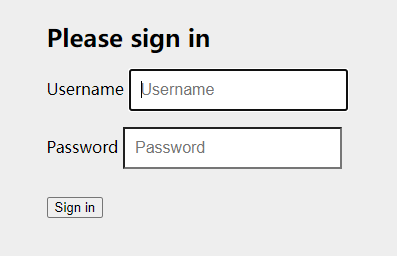
这是相当于,在我们的接口请求的前面做了一个拦截,类似filter,拦截后,跳转到了一个界面,让我们输入账号密码。这里,我由于没有设置账号密码,所以登录不进去。
设置访问一
下面设置一个账号密码,并且设置hello接口可以直接访问,设置很简单,就是注入两个bean,InMemoryUserDetailsManager和WebSecurityCustomizer,代码如下:
@Configuration
public class SecurityConfig {
/**
* 注册用户,这里用户是在内存中的
* {noop}表示“无操作”(No Operation)密码编码。
* @return
*/
@Bean
UserDetailsService userDetailsService() {
InMemoryUserDetailsManager users = new InMemoryUserDetailsManager();
users.createUser(User.withUsername("kiba").password("{noop}123").roles("admin").build());
return users;
}
/**
* 让hello可以不用登录,就可以直接访问,例如:http://127.0.0.1:8080/hello?name=kiba就可以直接访问
* @return
*/
@Bean
WebSecurityCustomizer webSecurityCustomizer() {
return new WebSecurityCustomizer() {
@Override
public void customize(WebSecurity web) {
web.ignoring().antMatchers("/hello");
}
};
}
}现在我们访问http://127.0.0.1:8080/user/123/roles/222,进入到登录页面,输入kiba/123就可以查看接口执行的结果了。
http://127.0.0.1:8080/hello?name=kiba就无需登录,可以直接访问。
登录一次,其他接口就可以自由访问了
控制请求
现在,增加一个类SecurityAdapter,继承自WebSecurityConfigurerAdapter。然后重写他的configure方法
@Configuration
@AllArgsConstructor
public class SecurityAdapter extends WebSecurityConfigurerAdapter {
/**
* authenticated():用户需要通过用户名/密码登录,记住我功能也可以(remember-me)。
* fullyAuthenticated()用户需要通过用户名/密码登录,记住我功能不行。
*/
@Override
@SneakyThrows
protected void configure(HttpSecurity http) {
http.httpBasic().and()
//禁用跨站请求伪造(CSRF)保护。
.csrf().disable()
.authorizeRequests().anyRequest().fullyAuthenticated();
}
}当使用,增加了SecurityAdapter后,我们重新请求http://127.0.0.1:8080/user/123/roles/222,得到界面如下:
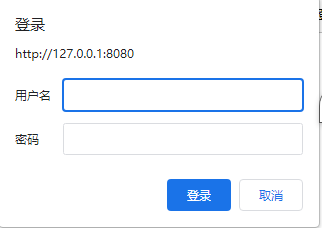
可以看到,登录界面的样式被美化了。
设置访问二(推荐)
我们还可以使用第二种方法,来做用户密码的配置。
通过重写configure(AuthenticationManagerBuilder auth)函数,来创建用户,这种方式创建用户会将前面的bean-UserDetailsService给覆盖,即,用户只剩下这里创建的。
代码如下:
@Configuration
@AllArgsConstructor
public class SecurityAdapter extends WebSecurityConfigurerAdapter {
/**
* authenticated():用户需要通过用户名/密码登录,记住我功能也可以(remember-me)。
* fullyAuthenticated()用户需要通过用户名/密码登录,记住我功能不行。
*/
@Override
@SneakyThrows
protected void configure(HttpSecurity http) {
http.httpBasic().and()
//禁用跨站请求伪造(CSRF)保护。
.csrf().disable()
.authorizeRequests().anyRequest().fullyAuthenticated();
}
@Override
protected void configure(AuthenticationManagerBuilder auth) throws Exception {
auth.inMemoryAuthentication()
.withUser("kiba518")
.password(passwordEncoder().encode("123"))
.authorities(new ArrayList<>(0));
}
@Bean
public PasswordEncoder passwordEncoder() {
return new BCryptPasswordEncoder();
}
}这里的用户是写死的,用户是可以修改成读取数据库的信息的。
我们查看WebSecurityConfigurerAdapter的代码,可以看到他有注解@Order(100),数越大,执行越优先级越低,即,他的执行顺序是相对比较靠后的。
授权OAuth2
授权这个设计理念是这样,它是结合上面的security的操作,实现了一个普通的WebApp转换成授权服务器WebApp。
授权服务器转换思路
我们先了解一下security转授权服务器的思路。
1,在这个应用里,创建一个auth接口,然后任何人想访问这个接口,就都需要输入账户密码了。
2,我们这个auth接口的返回值是个code,然后我们的前端,或者其他调用接口的APP,就可以把这个code作为用户登录的token了,。
3,然后我们再做一个接口,接受一个token参数,可以验证token是否有效。
这样我们这个授权服务器的搭建思路就构建完成了。
但按这个思路,我们需要做很多操作,比如创建接口,缓存token等等,现在spring提供了一个Oauth2的包,他可以帮我们实现这些接口定义。
OAuth2的接口如下,可以自行研究。
/oauth/authorize:授权端点
/oauth/token:获取令牌端点
/oauth/confirm_access:用户确认授权提交端点
/oauth/error:授权服务错误信息端点
/oauth/check_token:用于资源服务访问的令牌解析端点
/oauth/token_key:提供公有密匙的端点,如果使用JWT令牌的话
实现授权服务器
现在我们实现一个授权服务器。
先添加OAuth2的引用。
<dependency>
<groupId>org.springframework.security.oauth</groupId>
<artifactId>spring-security-oauth2</artifactId>
<version>2.4.0.RELEASE</version>
</dependency>然后增加配置文件AuthorizationConfig。
@Configuration
@EnableAuthorizationServer //开启授权服务
public class AuthorizationConfig extends AuthorizationServerConfigurerAdapter {
@Autowired
private PasswordEncoder passwordEncoder;
@Autowired
private AuthenticationManager authenticationManager;
@Override
public void configure(AuthorizationServerSecurityConfigurer security) throws Exception {
//允许表单提交
security.allowFormAuthenticationForClients()
.checkTokenAccess("isAuthenticated()");
}
@Override
public void configure(ClientDetailsServiceConfigurer clients) throws Exception {
clients.inMemory()
.withClient("client-kiba") //客户端唯一标识(client_id)
.secret(passwordEncoder.encode("kiba518-123456")) //客户端的密码(client_secret),这里的密码应该是加密后的
.authorizedGrantTypes("password") //授权模式标识,共4种模式[授权码(authorization-code)隐藏式(implicit) 密码式(password)客户端凭证(client credentials)]
.scopes("read_scope"); //作用域
}
@Override
public void configure(AuthorizationServerEndpointsConfigurer endpoints) throws Exception {
endpoints.authenticationManager(authenticationManager);
}
}然后打开SecurityAdapter,增加一个bean,如下,目的是让上面的AuthorizationConfig里Autowired的authenticationManager可以实例化。
@Bean
public AuthenticationManager authenticationManager() throws Exception {
return super.authenticationManager();
}然后使用APIFox调用一下/oauth/token接口。
先选择auth,输入账号密码,这个账号密码就是AuthorizationConfig里配置的客户端id和密码。
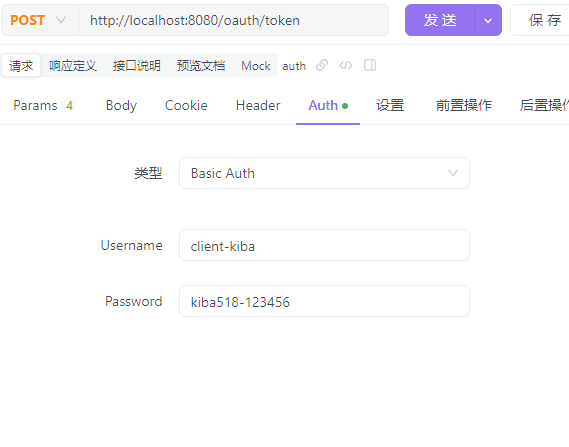
这个数据在请求时,会进行base64编码,然后以http的header属性Authorization的值的模式传递,如下。

然后输入参数,参数里scope和grant_type要和AuthorizationConfig里定义的scopes和authorizedGrantTypes一样,如下。
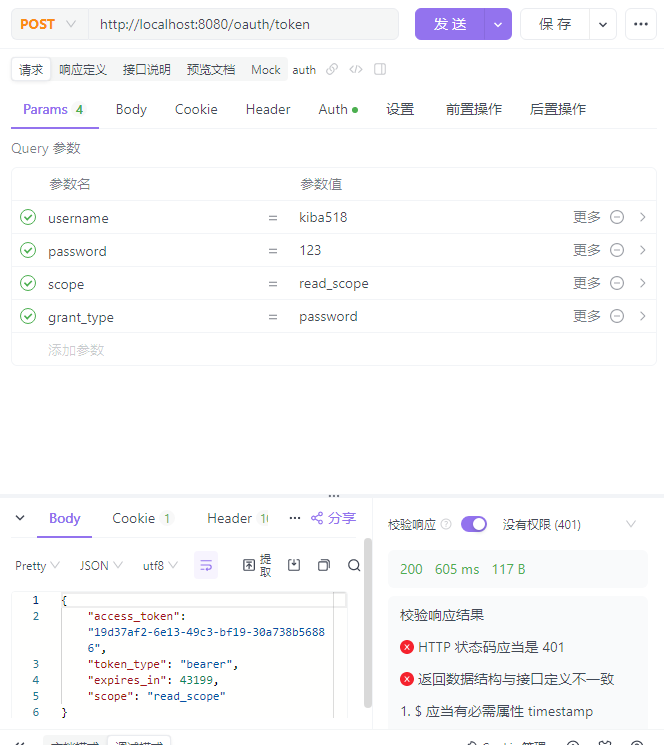
请求后,得到结果,如上图。
我们得到"access_token": "19d37af2-6e13-49c3-bf19-30a738b56886"。
有了access_token后,我们的前端其实就已经可以进行各种骚操作了。
资源服务
这个是Oauth为我们提供的一项很好用的功能。
我们创建一个项目做为资源服务。
添加依赖,版本与上面相同。
<dependency>
<groupId>org.springframework.boot</groupId>
<artifactId>spring-boot-starter-security</artifactId>
</dependency>
<dependency>
<groupId>org.springframework.security.oauth</groupId>
<artifactId>spring-security-oauth2</artifactId>
<version>2.4.0.RELEASE</version>
</dependency>然后编写资源配置,代码如下:
@Configuration
@EnableResourceServer
public class ResourceServerConfig extends ResourceServerConfigurerAdapter {
@Bean
public RemoteTokenServices remoteTokenServices() {
final RemoteTokenServices tokenServices = new RemoteTokenServices();
tokenServices.setClientId("client-kiba");
tokenServices.setClientSecret("kiba518-123456");
tokenServices.setCheckTokenEndpointUrl("http://localhost:8080/oauth/check_token");//这个接口是oauth自带的
return tokenServices;
}
@Override
public void configure(ResourceServerSecurityConfigurer resources) throws Exception {
resources.stateless(true);
}
@Override
public void configure(HttpSecurity http) throws Exception {
//session创建策略
http.sessionManagement().sessionCreationPolicy(SessionCreationPolicy.IF_REQUIRED);
//所有请求需要认证
http.authorizeRequests().anyRequest().authenticated();
}
}因为添加了spring-boot-starter-security,所以,我们请求这个资源WebApp,就都需要输入账号密码。
但因为,我们配置了ResourceServerConfig,这里我们配置了远程token服务,设置的信息是我们上面创建授权服务的信息。所以,在访问这个WebApp时,我们提供token即可。
使用APIFOX测试,先添加auth的token,内容是来自于上面,/oauth/token的返回值access_token的值。
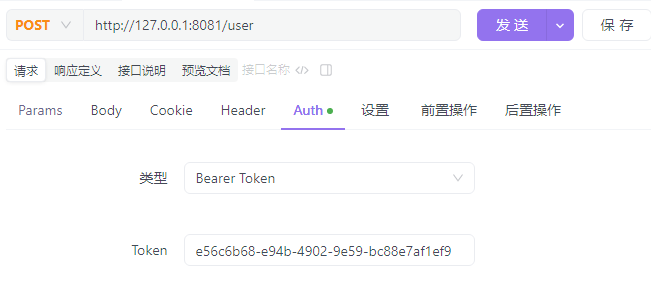
然后请求user接口,我这user接口没有参数,请求结果如下:
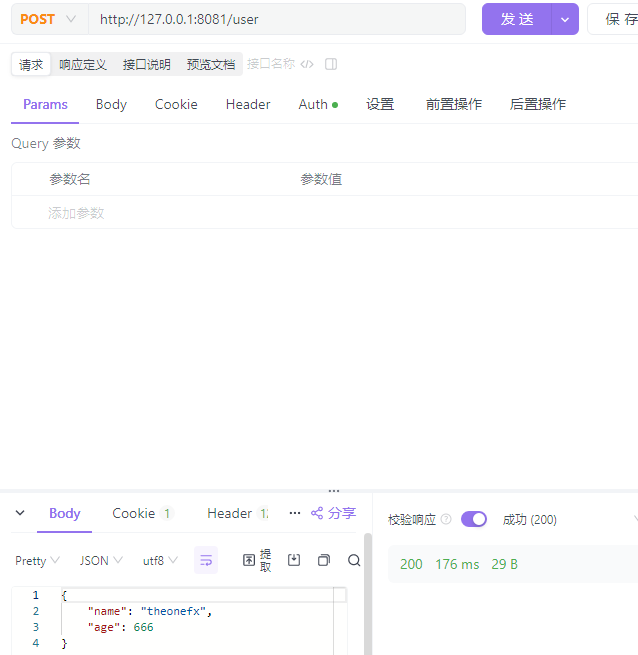
总结
这个授权服务挺好用的,就是配置太繁琐了,初学者不太好理解,而且功能太多,配置太闹心。
这个资源服务还是很贴心的,他提我们实现了,tokencheck的部分,但要注意的是,他这tokencheck是基于http请求的。
虽然Oath很好用,但,我还是觉得,这个认证部分自己写比较好,我们可以根据项目的需求,设计轻量级的授权认证。
比如,我们想减少http请求,把部分tokencheck在缓存内进行check,那使用oauth时,修改起来就会很头疼。如果是自己写的授权服务器,就不会有修改困难的问题。
注:此文章为原创,任何形式的转载都请联系作者获得授权并注明出处!

若您觉得这篇文章还不错,请点击下方的【推荐】,非常感谢!






















 7006
7006











 被折叠的 条评论
为什么被折叠?
被折叠的 条评论
为什么被折叠?










